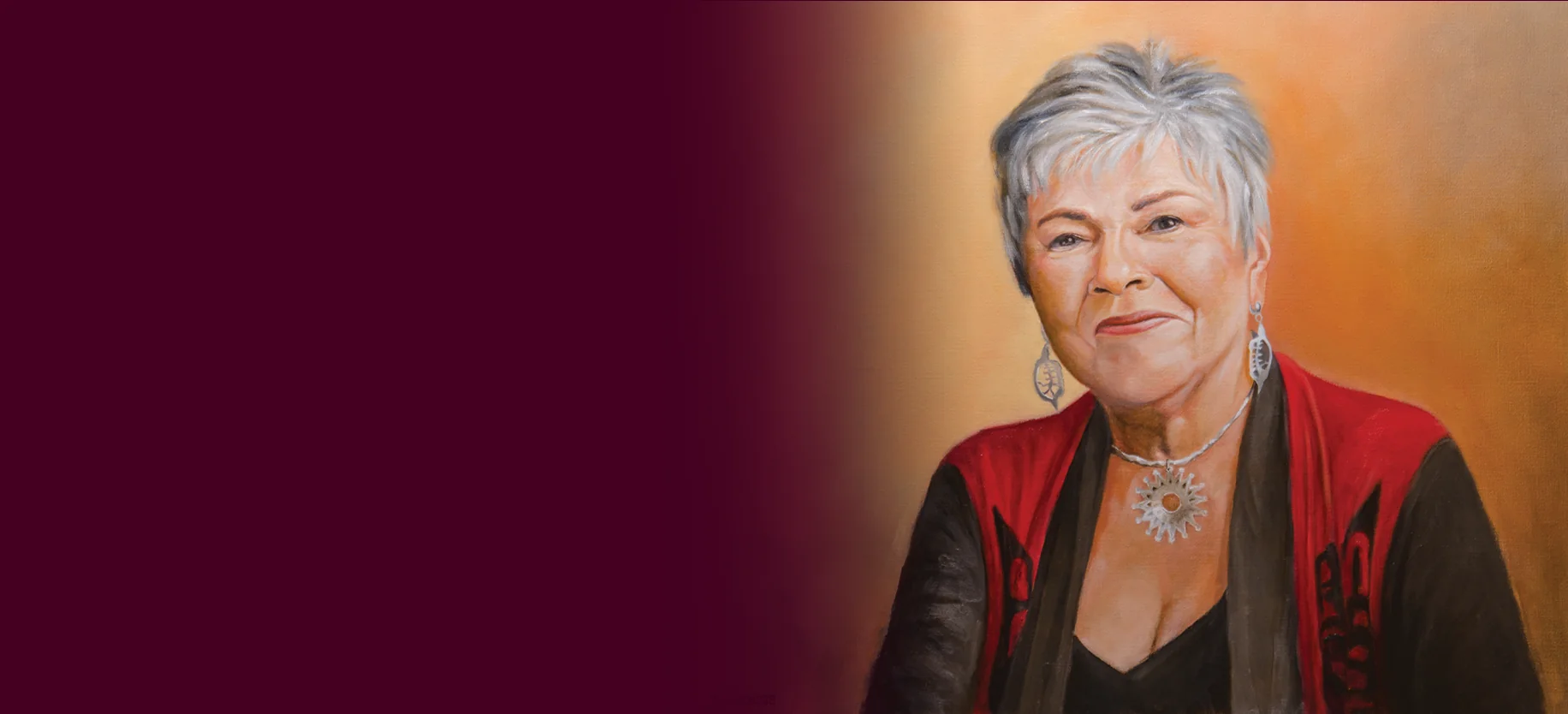A leader for Indigenous representation and rights in Canada.
A Mohawk from the Six Nations of the Grand River Territory, and an advocate for non-adversarial conflict resolution, Roberta Jamieson has charted a new path for Indigenous leadership and representation in Canada. Jamieson is the first Indigenous woman to earn a law degree in Canada, the first Indigenous woman elected chief of the Six Nations of the Grand River Territory, the first Indigenous Commissioner of the Indian Commission of Ontario, the first female Ontario Ombudsman, and the first non-Parliamentarian appointed as an ex-officio member in a House of Commons committee.1 When reflecting upon these staggering accomplishments, however, Jamieson asserts that she actually “didn’t seek to be first at anything.2 ” Instead, she says, “the opportunities were there, and I felt it was important to seize the opportunities and to occupy the space that had not been occupied by our people, or by women, because I felt those voices were lacking.3” Jamieson has indeed lived up to this ethos, using the platforms she has won and the opportunities she carved out for herself to advocate on behalf of Indigenous communities and women across the business, political, and non-profit landscapes.
Jamieson grew up on a Six Nations reserve near Brantford, Ontario, in a close-knit family consisting of eight children. She was influenced by the traditional Mohawk political practice of “holding council” – or gathering, debating, and talking for as long as necessary to achieve consensus.4 This style of negotiation would become Jamieson’s signature.5 Jamieson attended primary and secondary school on the reserve and began pre-med studies at McGill University. She would eventually pivot to study law, however, as a result of a few formative experiences: her political activism in support of an Indigenous community’s land rights, and her consequent realization that the law could be used as means of advancing Indigenous activism. At McGill, Jamieson became an advocate for the James Bay Cree community’s defense of traditional hunting and fishing territories. These lands were under threat of flooding due to the Quebec government’s 1971 plan to construct a hydroelectric dam in the region.6 Jamieson’s advocacy in support of the James Bay Cree prompted a realization for her: “if we’re ever going to solve issues between our people and others in Canada, we need […] tools in our toolbox. And so off I went to law school to get those tools.7” Jamieson consequently enrolled at the University of Western Ontario to study law in 1973. She was a founding member of the national Native Law Students Association while at Western and, upon graduating, became the first First Nations woman in Canada to earn a law degree.8 Despite the challenges of law school, Jamieson quickly realized that learning about the law would allow her to help Indigenous communities protect their interests and safeguard their rights.9 Jamieson “couldn’t understand why our people should accept all those outside people coming to our territory to tell us how to live or to make decisions for us… I knew from an early age that I was going to do something to change it. I have worked my entire life to build a Canada in which Indigenous people can once again find their rightful place.10”
After graduating from Western Law, Jamieson became involved in the Canadian Indian Rights Commission secretariat and worked as a speaker for the All-Chiefs Conference.11 She achieved another “first” in 1982 by serving as the first non-parliamentarian appointed to a committee – the Special Task Force on Indian Self-Government – in the House of Commons; the Task Force conducted important work such as producing a 1983 document entitled the Penner Report which offered a framework for Indigenous self-government. Jamieson would go on to chair the legal team that advised the Assembly of First Nations during a period of time that included constitutional negotiations, and she conducted mediation work between First Nations communities and both federal and provincial government bodies for 10 years.12
Jamieson was appointed the first female Ombudsman of Ontario in 1989 and remained in the position for a decade. A core component of her work as Ombudsman involved consultations with Indigenous communities to ensure that their voices were brought to the table.13 In this role, she was proud to launch for the first time “systemic investigations,” which was controversial at the time. She also worked to advance service equity to make public institutions more aware of the need for inclusive policies and practices, to serve the diversity of their public and to strengthen the governance of these institutions. As a member of the Board of the International Ombudsman Institute, she advised several countries who were establishing or working to strengthen their public institutions. She was named by the Prime Minister as a member of the Inaugural Gender Equality Advisory Council to the G7 Summit (2018) during Canada’s Presidency.
As the first female chief of the Six Nations of the Grand River Territory from 2001-2004, Jamieson worked to create a conflict-resolution mechanism, a decision-making system that was more inclusive, and a clearer distinction between the administration and politics of the nation.14
Jamieson served as the president and CEO of Indspire, the largest Indigenous-led charity in Canada, from 2004-2020. Indspire’s tagline, “Indigenous Education: Canada’s Future” has a double meaning: Canada will be strengthened by its fastest growing demographic group (Indigenous youth), and Canadians will become more aware or educated about the contributions of Indigenous peoples. In only one year of her tenure, the organization awarded 3,792 bursaries and scholarships grossing over $12.2 million to Indigenous students.15 Jamieson also served as an executive producer of the Indspire Awards, which are broadcast nationally to honor and celebrate Indigenous achievement and which represent “the highest honor the Indigenous community bestows upon its own people.16” Under Jamieson’s leadership, Indspire was recognized as one of the Top 10 Charities of Impact in Canada and experienced an eight-fold increase in its bursary program.17 Jamieson notes that the Indspire Awards recognize individuals who “are not only having a profound impact on their communities and the country, but who also serve as positive role models for Indigenous youth. Media images contribute greatly to how we think about ourselves and how others in society view us. It is imperative that as Indigenous people, we control our own narrative and the images we project.18”
Jamieson’s expertise and excellence have been widely recognized beyond her fields. She was recently appointed to the Royal Bank of Canada’s Board of Directors19 and Co-Chair of CN’s inaugural Indigenous Advisory Council,20 and has previously served on the boards of Hydro One Ltd., Ontario Power Generation, Deloitte, the Empire Club of Canada,21 the Royal College of Physicians and Surgeons,22 and Stewardship Ontario23. She is also the founding chair of the international media arts festival ImagineNATIVE and a founding board member of the Centre for Research in Women’s Health,24 Jamieson has been awarded over thirty honorary Doctor of Laws degrees and business and community awards, including the National Aboriginal Achievement Award (Law and Justice), the Indigenous Peoples Council Award of the Indigenous Bar Association, the Council of Ontario Universities’ David C. Smith Award,25 the inaugural Mary Parker Follett Award for conflict resolution, the Indigenous Women in Leadership Award from the Canadian Council for Aboriginal Business, and the Queen Elizabeth II Diamond Jubilee Medal.26 Jamieson was also appointed a Member of the Order of Canada in 1994 and an Officer of the Order of Canada in 2016.27
Throughout her formidable and wide-ranging career, Jamieson has never wavered in her commitment to Indigenous rights. She believes space is needed in Canada for Indigenous peoples to enrich our society with their expertise in conflict resolution, stewardship of the environment, and traditional healing, and that we can benefit from the role and wisdom of elders. She is clear in her ethos regarding advocacy: “change doesn’t just happen. It takes work, but it is achievable if we work together to make it happen.28” Indeed, Jamieson’s work and words come at a pivotal moment in the history of Canadian reconciliation with Indigenous peoples. Jamieson serves as a broad example of excellence in many regards, but she is especially inspirational for her impassioned pursuit of equity and inclusion for all people.
1. “Roberta L. Jamieson: Law and Justice,” Indspire. https://indspire.ca/laureate/roberta-l-jamieson-2/.
2. “Roberta Jamieson to Receive Honorary Degree from Algonquin College,” May 31 2021, Algonquin College. https://www.algonquincollege.com/news/2021/05/31/roberta-jamieson-to-receive-honorary-degree-from-algonquin-college/.
3. Ibid.
4. “Roberta L. Jamieson, O.C.,” The Governor General of Canada. https://www.gg.ca/en/node/122.
5. Ibid.
6. Ibid.
7. “Roberta Jamieson,” Algonquin College, https://www.algonquincollege.com/news/2021/05/31/roberta-jamieson-to-receive-honorary-degree-from-algonquin-college/.
8. “Extraordinary advocacy starts here: Roberta Jamieson, LLB’76, LLD’93, President and CEO, Indspire,” Western University. https://www.giving.westernu.ca/the-campaign/extraordinary-alumni/roberta-jamieson.html.
9. “Roberta L. Jamieson,” The Governor General, https://www.gg.ca/en/node/122.
10. Conn, “Roberta Jamieson,” https://www.thecanadianencyclopedia.ca/en/article/roberta-jamieson.
11. Ibid.
12. Ibid.
13. “Roberta L. Jamieson,” Indspire, https://indspire.ca/laureate/roberta-l-jamieson-2/.
14. Conn, “Roberta Jamieson,” https://www.thecanadianencyclopedia.ca/en/article/roberta-jamieson.
15. “Roberta L. Jamieson,” The Governor General, https://www.gg.ca/en/node/122.
16. “Roberta L. Jamieson,” Indspire. https://indspire.ca/laureate/roberta-l-jamieson-2/.
17. “Roberta Jamieson,” Algonquin College, https://www.algonquincollege.com/news/2021/05/31/roberta-jamieson-to-receive-honorary-degree-from-algonquin-college/.
18. McCormick, Nicole. “Trailblazer Roberta Jamieson continues to be a role model to Indigenous people.” June 7 2020, Toronto City News. https://toronto.citynews.ca/2020/06/07/trailblazer-roberta-jamieson-continues-to-be-a-role-model-to-indigenous-people/.
19. Royal Bank of Canada, “Roberta L. Jamieson to be appointed to the Board of Directors of Royal Bank of Canada,” July 14 2021, Cision. https://www.newswire.ca/news-releases/roberta-l-jamieson-to-be-appointed-to-the-board-of-directors-of-royal-bank-of-canada-887635768.html.
20. Canadian National Railway, “CN Proudly Announces Appointment of Ms. Roberta Louise Jamieson and The Honourable Murray Sinclair as Co-Chairs of Its New Indigenous Advisory Council.” April 27 2021, GlobeNewswire. https://www.globenewswire.com/news-release/2021/04/27/2217751/0/en/CN-Proudly-Announces-Appointment-of-Ms-Roberta-Louise-Jamieson-and-The-Honourable-Murray-Sinclair-as-Co-Chairs-of-Its-New-Indigenous-Advisory-Council.html.
21. Conn, “Roberta Jamieson,” https://www.thecanadianencyclopedia.ca/en/article/roberta-jamieson.
22. Ibid.
23. Royal Bank of Canada, “Roberta L. Jamieson,” https://www.newswire.ca/news-releases/roberta-l-jamieson-to-be-appointed-to-the-board-of-directors-of-royal-bank-of-canada-887635768.html.
24. Conn, “Roberta Jamieson,” https://www.thecanadianencyclopedia.ca/en/article/roberta-jamieson.
25. “Roberta L. Jamieson,” The Governor General, https://www.gg.ca/en/node/122.
26. Ibid.
27. Ibid.
28. Ibid.
This post is presented for illustrative and discussion purposes only. It is not intended to provide investment advice and does not consider unique objectives, constraints or financial needs. Under no circumstances does this post suggest that you should time the market in any way or make investment decisions based on the content. Select securities may be used as examples to illustrate Burgundy’s investment philosophy. Burgundy funds or portfolios may or may not hold such securities for the whole demonstrated period. Investors are advised that their investments are not guaranteed, their values change frequently and past performance may not be repeated. This post is not intended as an offer to invest in any investment strategy presented by Burgundy. The information contained in this post is the opinion of Burgundy Asset Management and/or its employees as of the date of the post and is subject to change without notice. Please refer to the Legal section of this website for additional information.

